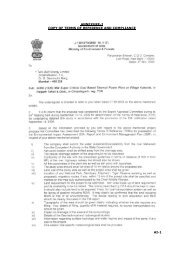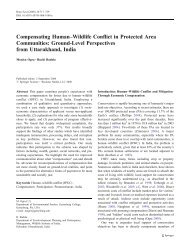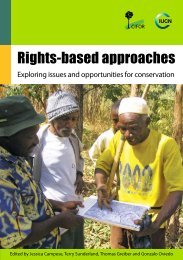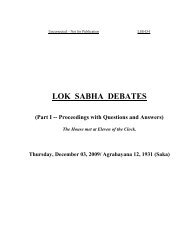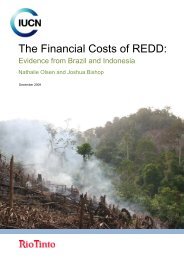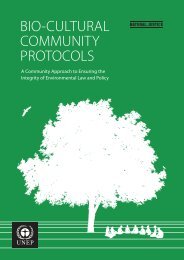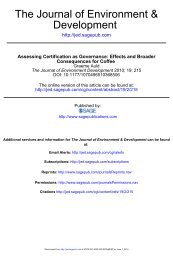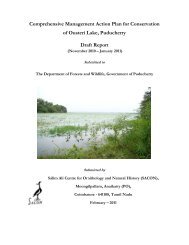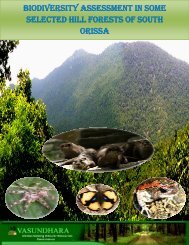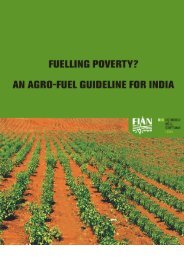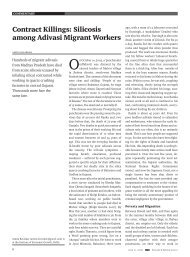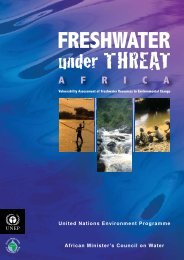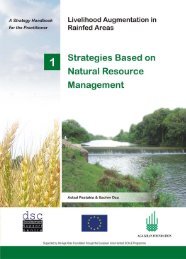Integrated River Basin Planning – Replicable ... - India Water Portal
Integrated River Basin Planning – Replicable ... - India Water Portal
Integrated River Basin Planning – Replicable ... - India Water Portal
You also want an ePaper? Increase the reach of your titles
YUMPU automatically turns print PDFs into web optimized ePapers that Google loves.
<strong>Integrated</strong> <strong>River</strong> <strong>Basin</strong> <strong>Planning</strong>: <strong>India</strong> and the EU share experience on policy and practice<br />
Conclusion and Recommendations<br />
This study has brought together the experiences obtained from various projects<br />
conducted abroad. A clear methodology was used to develop the Roadmap and<br />
is suitable for replication in other states. First of all, a participatory assessment of<br />
the water resources situations was conducted using the WRIAM tool. This tool<br />
has been developed to assess, in a participatory manner, the physical problems<br />
of the river basin. Based on the physical problems identified, management issues<br />
within the sectors governing water and sectors affected with water quality and<br />
quantity problems were identified and outlined. The data gathered in those<br />
participatory workshops allowed the experts to conduct a SWOT analysis which<br />
led to the recommended actions in the Roadmap. The approach used to develop<br />
this Roadmap has been positively received in a number of countries, but the<br />
momentum and continued commitment towards the implementation of actions<br />
will depend entirely on the commitment and willingness of the sectors involved to<br />
engage in further reforms.<br />
The actions for implementation identified in the current IWRM Roadmap will assist<br />
decision-makers with an agenda for future prioritization of activities. Stakeholder<br />
engagement was assured throughout the project. The identified water related<br />
issues were ranked by representatives of a selection of different sectoral<br />
government representatives as well as NGOs.<br />
An important management issue encountered is the enforcement of existing<br />
legislation. It was perceived that while there is no lack of proper legislation<br />
addressing water, its enactment and enforcement is poor. The inter-sectoral<br />
silos may prove to be difficult to demolish but, with the implementation and<br />
operationalization of the Authority, a platform for inter-sectoral coordination<br />
of different interests can be brought on the table. However, it is imperative to<br />
ascertain the Authority’s proper mandate. Follow-up and proper attention to the<br />
IWRM Roadmap process, and a willingness to embark upon reforms within the<br />
enabling environment, institutional framework and management instruments, will<br />
be decisive for its long-term success.<br />
Several legal and institutional challenges exist in the creation of an inter-sectoral<br />
mechanism dealing with pollution control and reduced availability of water. Those<br />
mechanisms are needed as part of the basin-wide control measures that need to<br />
be taken with reference to the<br />
(i)<br />
(ii)<br />
lack of adequate enforcement of environmental legislation;<br />
fragmentation of responsibilities among the water, environmental and<br />
agricultural authorities; and<br />
(iii) limited integration of environmental requirements into economic<br />
development policies.<br />
An additional urgent need is for the elaboration of a full assessment of the water<br />
quantity and quality based on integration of available data from the numerous<br />
departments involved in monitoring of the resource, for which sharing of data is<br />
imperative.<br />
IWRM and the EU <strong>Water</strong> Framework Directive (WFD) are largely based on the same<br />
principles, but the issues they deal with are very different. IWRM focuses on peoplecentered<br />
management, sectors and economy, poverty, lowest appropriate level,<br />
Pamba Pilot Project, Final Dialogue<br />
on IWRM, 29th October 2010<br />
gender sensitivity, public participation and decentralization.<br />
All these elements are of great importance to <strong>India</strong>, but less<br />
so to the EU WFD, which uses keywords such as protection,<br />
good status of waters, river basin management, water<br />
pricing, emission limits, streamlining legislation, and citizen<br />
involvement in planning 1 . This supports the choice to base<br />
the Pamba pilot on IWRM principles and not on the EU WFD.<br />
Nevertheless, there is still potential for <strong>India</strong> to review the EU<br />
WFD for elements that have proven their merit, such as a<br />
trans-boundary policy framework, institutional arrangements,<br />
and integration of sector-based interests. For purpose of<br />
reference, a summary of the EU WFD is provided in Annex 3.<br />
11.2 Recommendations<br />
Obviously, the actions identified in the Roadmap must be initiated, which for a start<br />
should be supported by a detailed budget estimate to conduct these actions and<br />
financing sources and specifics on who will implement the Roadmap elements. It<br />
is of high importance that the implementation of actions identified in the current<br />
roadmap commences immediately to ensure that the momentum created is kept<br />
up. It is unfortunately often seen that the momentum created as part of a given<br />
IWRM project slowly ends after the project has been finalized. As indicated in<br />
the Roadmap, some of the identified actions will need external funding and may<br />
require technical assistance. A way to ensure that funds are allocated for the<br />
continuous IWRM process is for the Government of Kerala to call, in the near<br />
future, for a roundtable meeting involving state and national actors to discuss<br />
funding possibilities with potential external partners.<br />
A key factor of further progress is the continual involvement of relevant stakeholders.<br />
A starting point may be to invite the stakeholder forum already established as<br />
part of the present project and perform regular consultations whenever major<br />
achievements or decisions concerning the IWRM implementation process in the<br />
Pamba <strong>River</strong> <strong>Basin</strong> are in place. In order to reach a broader stakeholder forum,<br />
the involvement of the press should also be considered in the future, which<br />
could be combined with IWRM capacity building of the media to ensure a better<br />
understanding and, thereby, coverage of the IWRM process in Kerala as such and<br />
in the Pamba <strong>River</strong> <strong>Basin</strong>.<br />
Of special importance is the effort needed towards operationalizing the Pamba<br />
<strong>River</strong> <strong>Basin</strong> Authority, especially at the basin level. Suggestions for organizational<br />
set-up, staffing and areas of responsibility have been provided as part of the<br />
present project. However, as stated in the Act, the Authority shall prepare<br />
implementation plans, budgets, financing plans, etc., which presently are absent.<br />
Setting up the PRBA should be in line with the preparation of the IWRM Action<br />
Plan; a proposal for the structure of this Plan has been provided as part of this<br />
project. The IWRM Plan should include a full situational analysis, a strategy on<br />
how to obtain the vision stated in the water policy and a portfolio of actions with<br />
1 As explained in: EU <strong>Water</strong> Framework Directive versus international principles concerning IWRM:<br />
the seven mismatches, Muhammad M. Rahaman, Olli Varis and Tommi Kajander: http://www.euwi.<br />
net/files/euwi/niki_tmpphp23UK4Y.pdf.<br />
64 65



